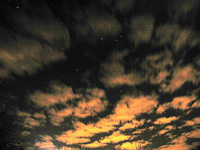 |
|
|
Global
Warming = Global Despair?
When it comes to sensationalism, there's nothing the media likes better
than a slow-moving apocalypse. Deadlines are extended and interviews are
lengthy. Scientists come out of the woodwork to comment on the growing
concern with "greenhouse gases" and CO2
levels. Searching for truth in the haystack of environmental theory often
reveals more questions than answers.
"There are at least nine and sixty ways of constructing a theory
of climactic change, and there is probably some truth in quite a number
of them," said Climatologist C. E. P. Brooks (Fleming
108). According to Greenpeace,
the Arctic is "warming three to five time faster than the global
average" (Climate
Countdown 2), prompting the average environmentalist to open his wallet
and throw money at the cause. Is the situation really as dire ("Countdown"
to what, exactly?) as Greenpeace would have us think?
According to Stephen Schneider, a Stanford scientist, it is "journalistically
irresponsible to present both sides" of global warming. "[W]e
have to offer up scary scenarios," he added, "make simplified,
dramatic statements, and make little mention of any doubts we may have"
(Hot Air 3).
Schneider's scary scenario hardly resembles the fire and brimstone images
painted by Greenpeace. Schneider called for "a decrease of the mean
surface temperature by as much as 3.5 degrees centigrade," which
"if sustained over a period of several years could be sufficient
to trigger an ice age." He made this statement in the late 1970s.
Schneider is now an outspoken advocate for global warming, not cooling.
"It would be fair to say that Schneider bears a large part of the
responsibility for making Greenhouse the hysterical public issue it has
become today," says John Daly, an Australian and self-described "Greenhouse
Skeptic" (Daly 1).
Rising Sea Levels
Greenpeace attests that rising sea levels change growing patterns in developing
countries. Soil becomes too salty for crops, and ocean currents change,
heavily impacting the fishing trade (Pacific
in Peril 1). On the other hand, regions above 40 degrees north latitude
are reportedly experiencing a longer growing season. Russia and Canada
are enjoying growing seasons that have been extended by as much as two
weeks above normal (Greener
Earth 1).
According to the EPA, the heath of polar bears has been on a decline for
the past 20 years due to higher temperatures and rising sea levels. These
rising sea levels have an interesting social effect on costal regions.
While in poor nations they negatively affect fishing and planting, in
more developed nations they create tension among waterfront homeowners.
This is a classic STS issue: property owners build sea walls protecting
their property but eliminating beaches. In the process, fishing is hurt,
and the breeding places for many birds (such as the least tern, an endangered
species (Interior Least Tern 1)) and crabs, their prey, are destroyed
(EPA:
Costal Zones 1).
The Ozone Layer
To New Zealanders, the hole in the ozone above them is nothing new; it
comes back around once a year. Since 1980, ultra-violet radiation levels
have increased from 10 to 12 percent over New Zealand, according to the
New Zealand National Institute of Water and Atmospheric Research (NIWA).
The hole is a result of the ozone attempting to repair itself above Antarctica,
where half of it is depleted every year (NIWA
1).
Conclusions
It is difficult to organize such a collection of global warming images
from around the world. My intention here is to show that the effects of
global warming are debatable, yet widespread. However, it is difficult
to prove that the rising sea levels and rising temperatures have an immediate
negative effect on the climates of the world. They are changing as the
climates adjust to the new temperatures. Social patterns change, and technological
fixes are applied when needed. Mankind will always adapt to his changing
environment. The question is how much he will change it before it becomes
unlivable.
|

